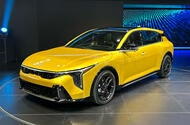Kia’s Ambitious Move: The K4 Hatchback and Its Potential Impact on the European Market
Kia is making waves in the automotive industry with the introduction of its new K4 hatchback, a model that aims to compete directly with established players like the Volkswagen Golf. Unveiled at the New York Motor Show, the K4 is set to be a significant addition to Kia’s lineup, particularly for global markets including North America, Asia, and the Middle East. But what does this mean for the European market, especially in light of the aging Ceed model?
Understanding the K4’s Design and Features
The Kia K4 will be available in two configurations: a traditional five-door hatchback and a liftback variant reminiscent of the Skoda Octavia. The hatchback version is notably shorter than the saloon, measuring 279mm less, which could enhance its maneuverability and urban appeal. Under the hood, buyers can expect a choice between a naturally aspirated 2.0-litre engine producing 147bhp and a more powerful turbocharged 1.6-litre option with 190bhp. This variety caters to different driving preferences, with the GT-Line and GT-Line Turbo variants featuring sport-tuned suspension for improved handling.
The K4 is scheduled to hit the U.S. market in late 2025, but its potential entry into Europe raises several questions. While Kia UK has indicated that there are no immediate plans for a European launch, the presence of test mules near Kia’s engineering center in Russelsheim suggests that the company is at least considering this option.
The Ceed’s Enduring Popularity and Future Prospects
Despite the automotive industry’s shift toward SUVs, the Kia Ceed has maintained a solid presence in Europe since its launch in 2018. Its continued success, even against newer competitors, indicates that there is still a market for compact hatchbacks. The larger Kia Sportage, for instance, achieved impressive sales figures, with 87,164 units sold during the same period.
However, the Ceed is approaching the end of its typical product cycle, which is around eight years. This raises the question of what Kia plans to do next. While there has been no official announcement regarding a next-generation Ceed, the K4 could serve as a strategic replacement.
The Shift Toward Electric Vehicles and Its Implications
As the automotive landscape evolves, the demand for electric vehicles (EVs) has not met the expectations of many manufacturers, including Kia. The upcoming EV4, an electric successor to the Ceed, shares similar dimensions and a five-door body style, but it may not be enough to fill the gap left by the Ceed in the interim.
Kia’s strategy to introduce more hybrid models globally is a clear indication that the company recognizes the need for a combustion-engine vehicle to bridge the gap until EV demand aligns with forecasts. Although the K4 currently lacks a hybrid option, it is among nine new models expected to receive hybrid powertrains by 2028. This could enhance its appeal in markets where consumers are still hesitant to fully embrace electric vehicles.
The Business Case for the K4 in Europe
Given the current automotive climate, the K4 hatchback could be a timely addition to Kia’s European lineup. If the demand for EVs continues to lag, a combustion-engine model like the K4 could provide a much-needed alternative. The fact that the K4 is built in Mexico also presents logistical advantages for Kia, potentially reducing costs associated with importing vehicles to Europe.
In summary, while the K4 hatchback is initially targeted at global markets, its potential entry into Europe could signify a strategic pivot for Kia. As the company navigates the complexities of evolving consumer preferences and market dynamics, the K4 may well become a key player in maintaining Kia’s competitive edge in the compact hatchback segment. With its blend of modern design, performance options, and the possibility of future hybrid variants, the K4 is poised to make a significant impact in the automotive landscape.

